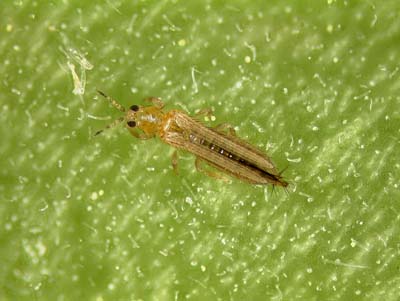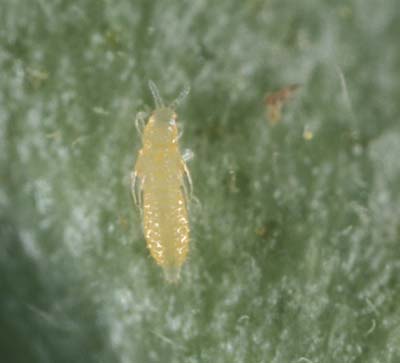Western Flower Thrips, Frankliniella occidentalis
(Thysanoptera: Thripidae)
The western flower thrips is found throughout the United States and has been spread by the movement of infested ornamental plants and vegetable seedlings from southern nurseries. It survives best in warm climates and overwinters on growing plants along the West Coast and in the southeastern United States. Numerous identified weed species that serve as alternate hosts for the western flower thrips. Many naturally occurring enemies are present in the field and help to maintain western flower thrips populations at low levels. The western flower thrips overwinters as adults and nymphs on many crops and weeds in mild climates. Many generations may occur under ideal conditions and a complete generation requires 15 days. The white egg is shaped like a bean. The larva resembles the adult but is smaller and wingless. Pupae may be found under debris or in cracks and crevices in the soil. The adult varies in color from yellow to brown and has two pair of fringed wings. Distinguishing the western flower thrips from other thrips species requires a trained specialist.
Vegetable crops that are commonly infested include cucumber, onion, pepper, potato, lettuce, and tomato. Tomato is most seriously injured directly by feeding of the thrips and indirectly by the tomato spotted wilt virus that they are capable of transmitting. Populations may be sampled in the field by visual examination, sticky traps, or blossom sampling. Insecticides are commonly applied in order to minimize feeding damage. The use of reflective mulch helps to reduce the incidence of tomato spotted wilt virus. Other cultural control practices include barriers and sanitation. The use of biocontrol agents may be economically feasible in greenhouse situations but due to the expense and dispersal tendencies of most beneficial organisms, field releases are not feasible. Conservation of naturally occurring insidious pirate bug, an important thrips predator, by limiting the use of broad spectrum insecticides, has resulted in reduced thrips populations in bell peppers grown in north Florida.
Images
To save the Web-optimized images shown below to your hard drive:
PC users: right click to "Save Picture (or Image) As..."
Mac users: click and drag to your desktop.
Copyright © 2005 University of Florida


